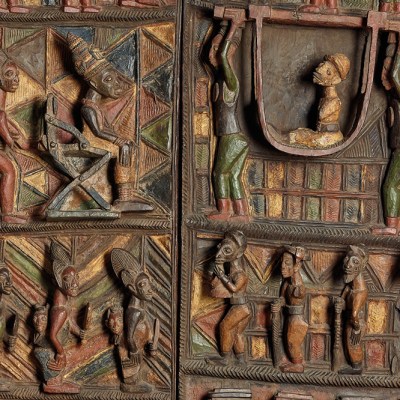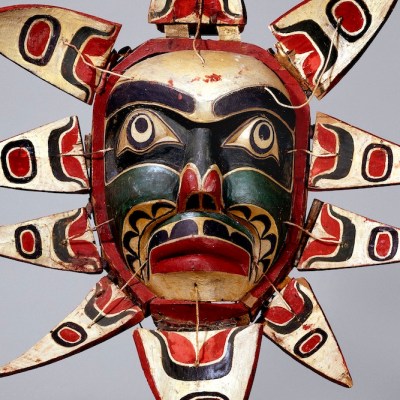From the July/August 2022 issue of Apollo. Preview and subscribe here.
Yoruba master carver Moshood Olusomo Bamigboye was the beating heart of his community in Kajola. Ahead of a survey at Yale later this year, curator James Green sees the whole world in one of his exquisitely detailed group scenes
Moshood Olusomo Bamigboye (c. 1885–1975) was never meant to be a sculptor. He came from an aristocratic family who, in the 12th century, according to oral tradition, moved from Ile-Ife – where the Yoruba believe their civilisation began – and settled in Kajola in present-day Kwara State, south-west Nigeria. His mother was a market trader, his father a farmer; Bamigboye was supposed to go into one of those professions. Crafts such as woodcarving or blacksmithing were generally passed down within the family among the Yoruba, with fathers taking on their sons or nephews as apprentices.
When Bamigboye was around seven years old, his parents saw him playing with a knife, cutting a banana leaf with such dexterity that they realised he was blessed with a rare talent – they understood it to be a divine gift. Bamigboye himself is recorded as describing his ability to carve as a gift from the gods; he said he had no master but that it took him 10 years to learn and fully develop his craft, which he continued to perfect throughout his career.
Bamigboye was also a herbalist, a priest of Ifa divination and king (Edemorun) of his town of Kajola. His sculptures reflect the many roles he held in his community. According to oral accounts, he was born in 1854 and fought in the Kiriji War (1877–93) – part of the broader Yoruba Civil Wars, which raged for much of the 19th century. Published accounts record his birth in around 1885 and I think this is more likely. It would mean that around 1900, or just after, he would have begun his training, so that by 1920 he had a well-established workshop with a regional reputation.
Equestrian shrine figure (ojubo elesin) depicting a priestess of Oya, (1920–40), Moshood Olusomo Bamigboye. Yale University Art Gallery, New Haven

The shrine figure dates from the early part of this mature period: from the 1920s or ’30s. It’s indicative of the sculpture he was carving for religious cults or associations at the time, of which there were many dedicated to the Yoruba orisha (gods). He might have been commissioned by the head of a family who had a shrine dedicated to Oya in their compound or by the priest in charge of the shrine.
We know that the work is by Bamigboye thanks to the original research of art historian William Buller Fagg (1914–92) and wood carver Lamidi Fakeye (1925–2009), who based their attribution on the style’s distinct qualities. In the 1970s, Fakeye identified the works of a number of Yoruba carvers in museums in Europe and the United States. We also have Fakeye to thank for identifying figure as a representation of a devotee of Oya – an orisha and the wife of the thunder god Shango. He noticed the figure has a thunderstone, a neolithic celt or adze on her forehead – a sign of Shango, who was believed to hurl these as lightning strikes at those who offended him. Seated behind the priestess is a figure carrying a leather bag (apo awo). These were used by Shango practitioners to carry equipment and when not in use, were hung behind shrines to Shango.
Equestrian shrine figure (ojubo elesin) depicting a priestess of Oya, (1920–40), Moshood Olusomo Bamigboye. Yale University Art Gallery, New Haven

The hundreds of orisha in the Yoruba pantheon are seldom represented directly, so this work has been interpreted as a devotee or priestess of Oya, rather than the orisha herself. It is extremely rare to see a female figure raised upon a horse in Yoruba art. Usually only male warriors and kings are presented on horseback. In this image you have a conflation of masculine and feminine strength: a balance of forces. Where Shango, the deified fourth king of the Oyo Empire, is the god of thunder and lightning, his wife embodies a disarming, soothing power. The pigments – white chalk (efun) and blue (a synthetic colour from a laundry bluing detergent called Reckitt’s blue) – have also been interpreted as representing coolness and balance.
Bamigboye’s work is extraordinary for the sheer level of detail he manages to include in depicting the world around him. This sculpture gives a vivid sense of the material culture of his hometown of Kajola in the 1920s and ’30s. The group of figures gathered around the priestess, the clothes they wear and the objects they carry reveal a religious festival dedicated to Oya in action. The priestess has come to the shrine bearing a rooster – a standard sacrificial offering. In her other hand is a flag associated with the court and cool-headedness in political decision-making, offering a counterbalance to Oya’s hot-headed husband.
In Yoruba tradition, the scale and positioning of the figures indicate hierarchy. You find this in the art traditions of the wider region, such as the neighbouring kingdom of Benin, especially in portraits of the Oba (king) and his retinue in 16th-century bronzes. It is clear who’s in charge here: this female figure, elevated on her horse, is surrounded by smaller figures representing the world over which she has dominion. Yet each also has an individual identity: the head of the figure at the front of the saddle is half-shaved, denoting a trainee priest of Shango. You have the Shango priest behind her, with his bag; the two figures on the left touching one another’s genitals, interpreted as a sign of procreation and fertility. On the right are two musicians, blowing a flute and beating a dundun drum. Together, they all combine to give a sense of the individual members of society and the bustle and noise of a festival.
The whole scene was carved from a single piece of wood, likely ire (a rubber tree). This is a light wood, which holds the knife mark very well but isn’t very insect-resilient, as you can see at the base. Sculptures like this are completed in five distinct stages. In the first stage the form is blocked out using an adze, then the sculptor moves on to the more detailed carving using knives. Wood carving is an extractive process – you can’t undo your marks, so you have to have a clear idea of what you want to do before you begin. As I was told by a Yoruba sculptor during a presentation I gave in Lagos, it’s important to picture the sculptor turning the piece around in his hands as he worked. Notice the different channels of access around the horse’s feet – these would allow him to get his hand round to the underside of the horse to complete all the fine-detail work.
Equestrian shrine figure (ojubo elesin) depicting a priestess of Oya, (1920–40), Moshood Olusomo Bamigboye. Yale University Art Gallery, New Haven

Apprentices help, depending on their ability, but the master generally takes over at two crucial stages: the second (ona lile), when the proportions are determined with an adze, establishing the feel of the piece, and the final stage (finfin), when the detailed carving is completed with knives. The intricate carving on the flag here is beautiful; Bamigboye delighted in filling every available surface with ornamentation, either figurative or geometric. You see some of his geometric patterning on the flag. The area of northeast Yorubaland where Bamigboye came from was part of the Ilorin Emirate in the late 19th century and was considered part of northern Nigeria during the period of British colonialism. There are strong Islamic influences on the Yoruba arts of this region. Bamigboye later came to focus more on geometry, especially after he converted to Islam in the 1960s and took the name Moshood.
Bamigboye represents the apogee of the Yoruba carving tradition at a moment when the world was changing around him. In 1931, a wave of iconoclasm swept through the neighbouring towns, led by the self-proclaimed prophet Joseph Babalola (1904–59). It called for the abandonment of many shrines and the destruction of thousands of religious carvings, including works by the artist. Bamigboye became a carving instructor in a British school and had to find new European clients for his work – though he was wary of the British. He never learned to speak English (though he probably understood it well) and, while he had the chance to travel internationally, he chose to stay in Kajola, continuing his work as a sculptor and healer, as the king of his town and as a judge on the local court.
While we know of him as a sculptor, his family continue to think of him first and foremost as a healer, a father and a man known for his generosity of spirit. The objects he made, such as this shrine figure, were above all about maintaining networks and relationships: he was paid for his work in kind, through food and labour. He served as the keeper of masks for his town when they were not in use and the local festivals where his masks were performed were an opportunity for people to come together around a common cause: in celebration of the planting of crops, in hopes for a good harvest and to ensure the forces of the spiritual world (orun) were honoured so that peace and stability in the living world (aye) would be maintained. ο
As told to Samuel Reilly.
James Green is associate curator of African art at Yale University Art Gallery, New Haven, where ‘Bamigboye: A Master Sculptor of the Yoruba Tradition’ will be on show from 9 September–8 January 2023.
From the July/August 2022 issue of Apollo. Preview and subscribe here.


